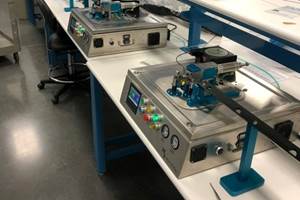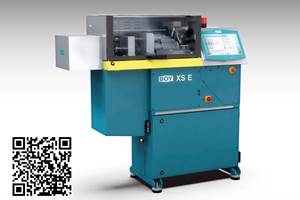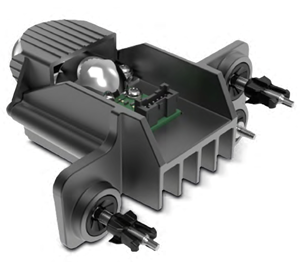Injection Molder Finds Big Opportunities in Micromolded Parts
Less than a single pellet's worth of resin is all one custom injection molder needs to produce micro-sized precision parts with undercuts, ribs, hinges, or inserts. These minuscule parts must be held to tolerances of ±0.0005 in. with CpK's of 1.3 or better, which means no more than about six defects in 100,000 parts.
The firm, Micromold Inc., Riverside, Calif., is considered a leader in the new field of micromolding--injection molding parts with outside dimensions no larger than 0.5 in. Making plastic gears, posts, housings, and other parts in the size range of 0.5 to 0.75 in. has been one of the firm's specialties since it was established in 1979. But Micromold hasn't produced a part larger than 0.375 in. for the past year, according to Robert Aust, president of the $5-million/yr firm.
Demand for "micro" parts has grown in the past four or five years from medical, electronic, and computer industries, where miniaturization is a way of life. How small is small? The weights of four proprietary parts currently manufactured by Micromold range from 0.05 g down to 0.007 g. One insert-molded part has a 0.0450-in. O.D. and 0.0260-in. wall thickness with molded-in details.
"Take an eight-cavity mold with a part weight at 0.007 gram and the runner system at 3.11 gram. The runner is over 50 times the weight of the parts themselves," says Ronald Peterson, general manager. Another way to look at it, he says, is that roughly 98% of every pellet used is waste, and 2% is the precision parts.
Incidentally, a standard pellet weighs about 0.023 g. "In some cases we can make three parts from one pellet," not counting the runner system, Peterson notes.
An added challenge is that micro-molded parts usually require engineering-grade materials to meet performance requirements. For example, Micromold uses polycarbonate with 20% glass fiber, 20% carbon fiber, and 5% PTFE to make a spindle hub with 25-mm diam. and 0.005 mm concentricity. Other materials the firm molds include ABS, PC/ABS, TPU, TP polyester, nylon, acetal, LCP, and PEEK. Typical fillers include Kevlar, PTFE, carbon fiber, and glass fiber or beads.
Although Micromold produces about 75 million micro-sized parts a year, it doesn't look like a big customer to the resin firms. "Resin companies want to sell railcars of material, but when we place an order we only need a few bags," Peterson quips.
It's not for everyone
"Other molders are turning down these precision small-part jobs, or are failing to deliver, because they just cannot hit the highly demanding tolerances," says Aust. "When it comes to sharp detail and tight tolerances, it requires a specialized mold shop with a combination of precision CNC machining centers, wire EDMs, and conventional EDMs, as well as precision molding machinery and measuring equipment to get the job done," adds Peterson.
Parts handling is not only awkward with such tiny parts, it requires delicacy, too. "On a large part, a 0.001-in. or 0.002-in. ding may not be important but an imperfection that size is a significant feature on a micromolded part. It can be the size of one of the molded details," Peterson notes.
So how does Micromold succeed where others have not? Aust says it requires close attention to machinery, tooling, processing, and material quality, plus zealous quality inspection.
One of the basic necessities for micromolding is small and precise injection machines. "About 10-50% of the shot capacity of the machine is used in micromolding applications," says Peterson. Micromold has 28 horizontal and vertical presses ranging from 4 to 34 tons. Twenty-three of them come from Boy Machines Inc. Exton, Pa. The remaining machines include four old Dynacast models and one Newbury press. Seven of Micromold's newer units have Boy's Procan and Procan-II closed-loop microprocessor controls, which Aust and Peterson say allow for extremely precise, reliable, and repeatable molding of tight-tolerance micro parts. Peterson says the Procan-equipped machines hold part dimensions to 0.0002-in. deviation over a four-cavity mold.
"We use the older machines in applications where precise control is not an issue, like insert molding, and in parts where variations in the process do not affect part dimensions. The Procan machines are used for the newer jobs we are quoting and running," says Peterson.
Although most of its job runs are from tens of thousands into the millions of parts, Micromold typically uses molds with low cavitation. Aust explains that one-, two-, or four-cavity molds are critical to achieving tight tolerances. Using two twin-cavity molds instead of one four-cavity mold tends to keep molding problems to a minimum. "Other firms failed because they went with larger cavitation tools," Aust says. The firm also uses hot runners to avoid a large waste of material, but only when it offers a significant cost reduction to the customer.
Achieving precise part dimensions is partly a matter of paying closer attention to detail during tool design, says Peterson. Even prototype tools here are built to Class 101 standards, where a core and cavity can typically handle 1 million or more shots. Tools are designed to meet CpK values of 1.3 to 2.0, which translates into defect rates from 60 ppm down to 2 ppb. Most jobs meet a CpK of 1.7 or better, which works out to a defect rate of 11 ppm or less.
Every part gets checked
Perhaps the biggest part of Micromold's success with tiny parts is its six stringent quality-control checks. The first inspection is to confirm the identity of the incoming raw material. The second is a check of the press set-up. Then there is a machine inspection and simple visual part inspection every 30 minutes. During the machine inspection, even the part drop-out chutes are checked, since dings in parts as small as 0.0005 in. can occur here, says Aust.
Every six hours, an in-process SPC check involves pulling two parts and checking two to 10 control dimensions using an optical measuring machine, a touch-probe, or both methods.
Next, there is 100% visual inspection of every part produced. Each part is examined under a microscope or magnifying lens. Finally, Micromold has a different QC person conduct a last inspection to make absolutely sure the parts are correct. This involves checking 80 parts per 1000 under the same criteria as the 100% inspection performed earlier. If one flawed part is found in the lot, the lot is rejected. All inspections are documented, and the results are made available to the customer. Micromold sends in-process SPC charts along with each shipment.
The parts are counted and packaged, and inspection labels are affixed to the individual bags and boxes to ensure product traceability. Some parts are so delicate they are placed in specially designed thermoformed trays to prevent damage. This approach allows Micromold to ship parts with near zero defects, says Peterson. The real number works out to be a theoretical 11 defective parts per million at a CpK of 1.73.
Related Content
Innovative Micro-Molding From Minnesota Machine Shop
Machine shops are natural inventors, but not necessarily suited to supporting and marketing a product. This Minnesota shop with an invention related to micromolding will share it through licensing.
Read MoreNew Machine Range Features Adjustable Clamp for Micromolding
The Boy XS E, successor to the XS series, features servodriven pump drives and different clamp configurations, as well as a special mold holder for optional micromolding operation.
Read MoreSlimmer All-Electric Press Debuts
A slimmed-down version of Engel’s all-electric, e-mac injection molding machine is among eight displays, which also include LSR micromolding, quick mold changes and a cube mold.
Read MoreX2F and Covestro Collaborate on Innovative In-Mold Electronics for Automotive Lighting
Thermally conductive PC heat-sinks produced with X2F controlled viscosity molding.
Read MoreRead Next
Processor Turns to AI to Help Keep Machines Humming
At captive processor McConkey, a new generation of artificial intelligence models, highlighted by ChatGPT, is helping it wade through the shortage of skilled labor and keep its production lines churning out good parts.
Read MoreHow Polymer Melts in Single-Screw Extruders
Understanding how polymer melts in a single-screw extruder could help you optimize your screw design to eliminate defect-causing solid polymer fragments.
Read MoreTroubleshooting Screw and Barrel Wear in Extrusion
Extruder screws and barrels will wear over time. If you are seeing a reduction in specific rate and higher discharge temperatures, wear is the likely culprit.
Read More


























